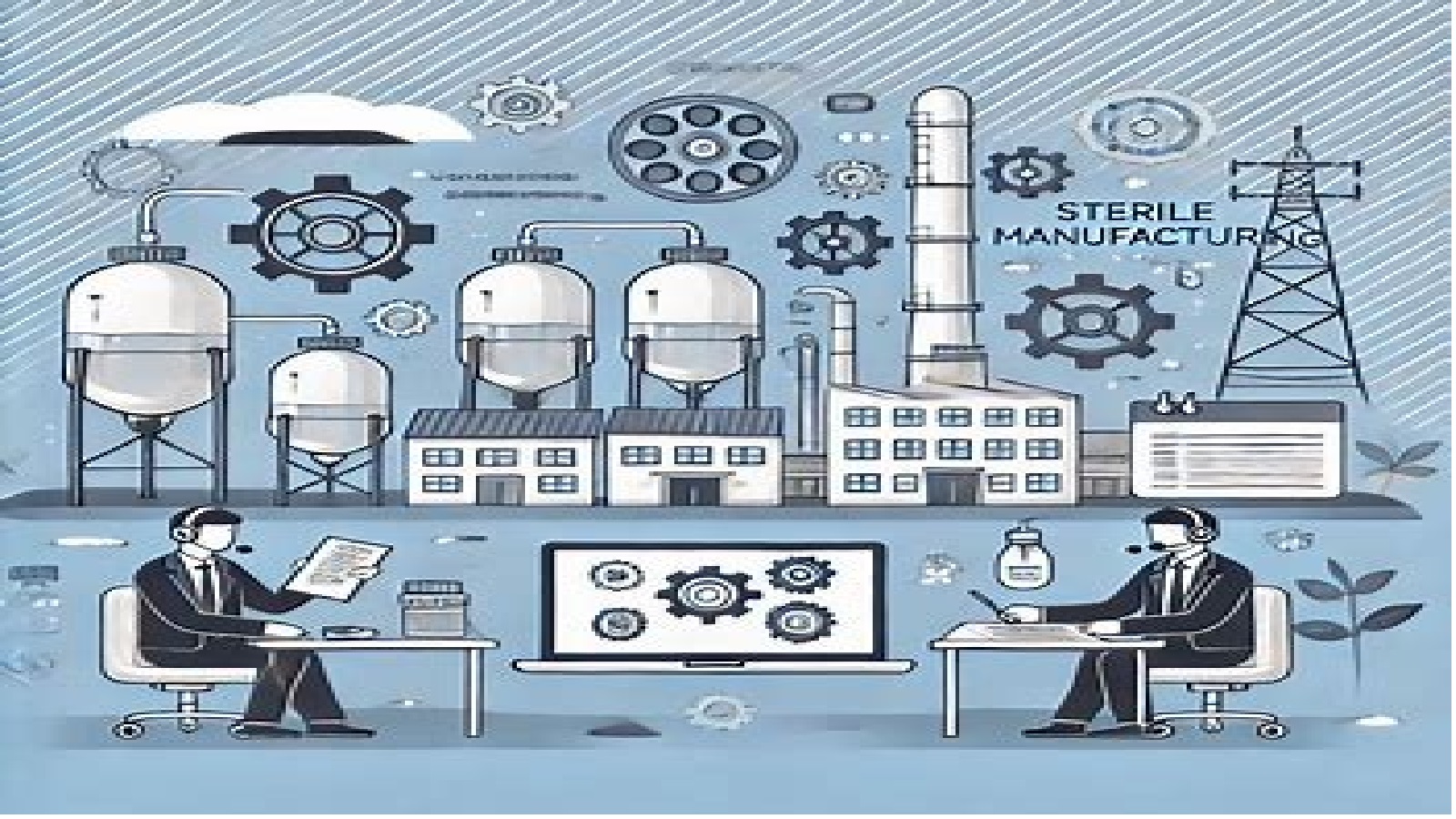Sterile manufacturing is a critical process in pharmaceutical and biotechnology industries, ensuring the production of safe and contamination-free products. Preparing for an interview in this field requires a strong understanding of core principles, regulations, and practical applications. This article outlines common interview questions and key concepts, structured for ease of study.
1. Understanding Sterile Manufacturing
a. What is Sterile Manufacturing?
Sterile manufacturing involves producing pharmaceutical products free from viable microorganisms, ensuring patient safety and efficacy.
b. Why is Sterility Important in Pharmaceuticals?
Sterility prevents contamination, which could compromise product quality, efficacy, and patient health, particularly in injectables and ophthalmic products.
2. Common Interview Questions in Sterile Manufacturing
a. General Questions
- What is sterile manufacturing, and why is it critical in pharmaceutical production?
- Describe the difference between aseptic processing and terminal sterilization.
- Explain the key steps in the sterile manufacturing process.
b. Regulatory and Compliance
- Which regulatory guidelines govern sterile manufacturing?
- How do you ensure compliance with Good Manufacturing Practices (GMP)?
- What is the significance of an FDA 483 observation in sterile manufacturing?
c. Facility Design
- Why is facility layout critical in sterile manufacturing?
- What is the role of cleanrooms, and how are they classified?
- Explain the importance of unidirectional airflow in sterile facilities.
d. Equipment and Validation
- What are the key pieces of equipment used in sterile manufacturing?
- How is sterilization equipment validated?
- Describe the principles of autoclaving and dry heat sterilization.
e. Microbiological Control
- What are the common sources of contamination in sterile manufacturing?
- How is environmental monitoring performed in sterile facilities?
- Explain the importance of endotoxin testing.
3. Key Concepts in Sterile Manufacturing
a. Cleanroom Classification
Cleanrooms are classified based on particulate matter and microbial counts. Common standards include ISO classifications (ISO 5, ISO 7, ISO 8) and EU GMP grades (Grade A, B, C, D).
b. Aseptic Processing
Aseptic processing involves maintaining sterility by preventing contamination during manufacturing and packaging. It includes stringent environmental controls, personnel practices, and validated processes.
c. Sterilization Techniques
- Steam Sterilization (Autoclaving): Uses high-temperature steam under pressure to kill microorganisms.
- Dry Heat Sterilization: Eliminates pyrogens and microorganisms using high temperatures without moisture.
- Gas Sterilization: Uses ethylene oxide or hydrogen peroxide vapor for temperature-sensitive materials.
- Radiation Sterilization: Employs gamma rays or electron beams for sterilizing medical devices and pharmaceuticals.
d. Environmental Monitoring
Regular monitoring of air, surfaces, and personnel is essential to detect microbial contamination. Techniques include active air sampling, settle plates, and contact plates.
e. Personnel Training
Proper training ensures that employees follow aseptic techniques, gowning procedures, and adhere to contamination control measures.
4. Common Challenges in Sterile Manufacturing
4.1. Contamination Control
a. Sources of Contamination
- Human Personnel: Employees are the primary source of contamination due to improper aseptic techniques or non-compliance with gowning protocols.
- Environment: Airborne particles, microorganisms, and equipment surfaces contribute to contamination risks.
- Materials: Raw materials, packaging components, and tools can introduce contaminants if not sterilized properly.
b. Managing Contamination Risks
Implementing robust environmental monitoring, regular training programs, and advanced cleanroom technology are essential to mitigate contamination risks.
4.2. Maintaining Cleanroom Integrity
Cleanrooms are the backbone of sterile manufacturing, but ensuring their integrity poses several challenges:
- Unidirectional Airflow Disruptions: Any disturbance in airflow can compromise sterility.
- Cleanroom Classification Adherence: Strict adherence to ISO and GMP standards requires continuous monitoring and frequent testing.
- Wear and Tear: Regular use of cleanrooms leads to wear on surfaces and equipment, requiring ongoing maintenance and validation.
4.3. Aseptic Processing
a. Complex Procedures
Aseptic processing involves multiple steps that must be flawlessly executed. Any deviation can compromise sterility.
b. Operator Dependence
Despite automation, aseptic processes rely heavily on operator expertise. Mistakes during manual interventions can result in batch failures.
4.4. Regulatory Compliance
a. Evolving Guidelines
Global regulatory bodies such as the FDA, EMA, and WHO frequently update guidelines, necessitating constant adaptation by manufacturers.
b. Documentation Requirements
Comprehensive documentation of processes, validations, and deviations is mandatory, increasing administrative workloads.
c. Inspection Preparedness
Facilities must always be audit-ready to avoid compliance issues, warning letters, or production halts.
4.5. Equipment and Validation
a. High Costs
Sterile manufacturing requires specialized equipment, such as isolators, autoclaves, and cleanroom HVAC systems, which are expensive to install and maintain.
b. Validation Challenges
Ensuring equipment performs consistently within required parameters demands extensive validation and regular revalidation efforts.
c. Downtime for Maintenance
Frequent equipment maintenance can disrupt production schedules, impacting delivery timelines.
4.6. Microbiological Monitoring
a. Sensitive Detection
Detecting microbial contamination at ultra-low levels requires sophisticated equipment and highly trained personnel.
b. Real-Time Analysis Limitations
Most microbiological tests, such as sterility or bioburden testing, take time, delaying production decisions.
4.7. Endotoxin and Pyrogen Control
Pyrogens, including bacterial endotoxins, can remain in sterilized products. Ensuring endotoxin levels are within acceptable limits requires rigorous testing protocols, such as the Limulus Amebocyte Lysate (LAL) test.
4.8. Product Stability
a. Sterilization Impact on Products
Some pharmaceutical compounds degrade under high temperatures or radiation used during sterilization. Manufacturers must balance sterility with product stability.
b. Packaging Challenges
Sterile products require specialized packaging that maintains sterility throughout the product’s shelf life, adding to costs and complexity.
4.9. Personnel Training and Retention
a. High Skill Requirements
Sterile manufacturing demands highly trained personnel, especially for aseptic processing and environmental monitoring.
b. Retention Challenges
The technical nature of sterile manufacturing leads to high turnover rates, requiring ongoing investment in recruitment and training.
4.10. Supply Chain Disruptions
a. Raw Material Availability
Delays or contamination of raw materials can halt production processes.
b. Regulatory Barriers
Import/export regulations for sterile equipment and raw materials can disrupt supply chains, affecting production timelines.
4.11. Technology Integration
a. Balancing Automation and Human Oversight
While automation reduces contamination risks, it requires significant investment and expertise to integrate seamlessly with manual operations.
b. Upgrading Legacy Systems
Transitioning from older equipment to advanced technology can be expensive and disruptive but is often necessary for compliance and efficiency.
4.12. Cost and Time Pressures
a. High Production Costs
Sterile manufacturing involves substantial costs for facility design, equipment, personnel, and testing.
b. Time Constraints
The need to meet market demand while adhering to stringent quality controls often creates production pressures.
5. Preparing for a Sterile Manufacturing Interview
a. Understand Regulatory Guidelines
Familiarize yourself with guidelines such as:
- FDA’s Code of Federal Regulations (CFR) Part 211
- EU GMP Annex 1
- ISO 14644 Standards
b. Revise Core Concepts
Review key principles of sterilization, cleanroom design, microbiology, and process validation.
c. Practical Experience
Highlight hands-on experience with sterilization equipment, cleanroom operations, or quality control activities.
d. Communication Skills
Demonstrate the ability to explain complex concepts clearly and concisely, as communication is vital in regulated industries.
6. Conclusion
Sterile manufacturing is a cornerstone of pharmaceutical production, ensuring the safety and efficacy of critical products. Understanding its principles, regulations, and challenges can help candidates excel in interviews. By focusing on the questions and concepts outlined in this article, you can prepare effectively and demonstrate your expertise to potential employers.
This structured approach ensures you are well-prepared for any sterile manufacturing interview while gaining a deeper appreciation of the industry’s complexities and importance.
For more articles, Kindly Click here.
For pharmaceutical jobs, follow us on LinkedIn
For Editable SOPs in Word format contact us on info@pharmaceuticalcarrier.com
For more information kindly follow us on www.pharmaguidelines.co.uk
Dr. Gite, a Ph.D. graduate from the Elite Institute of Chemical Technology, Mumbai, and a Master’s in Pharmaceutics from UDCT, Aurangabad, is a renowned pharmaceutical scientist. With expertise in oral protein and peptide drug delivery, nanotechnology, NDDS, and complex injectables, Dr. Gite has a proven track record in advancing innovative drug delivery systems.
Specializing in biosimilars, biologics, and ocular drug delivery, Dr. Gite is also well-versed in DoE, QbD, regulatory affairs, and technology transfer. Driven by a passion for innovation, Dr. Gite is dedicated to shaping the future of pharmaceutical research and healthcare.





